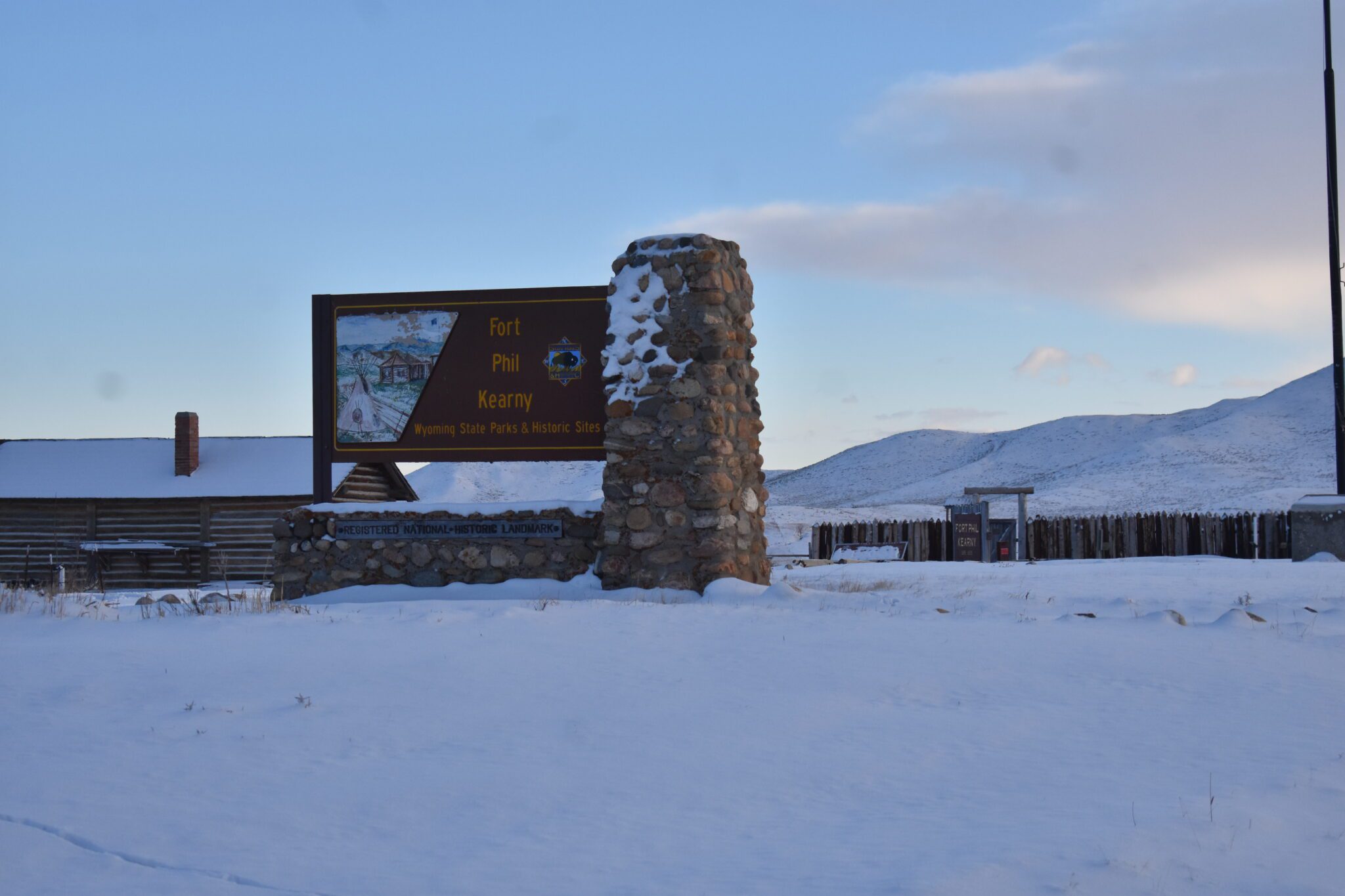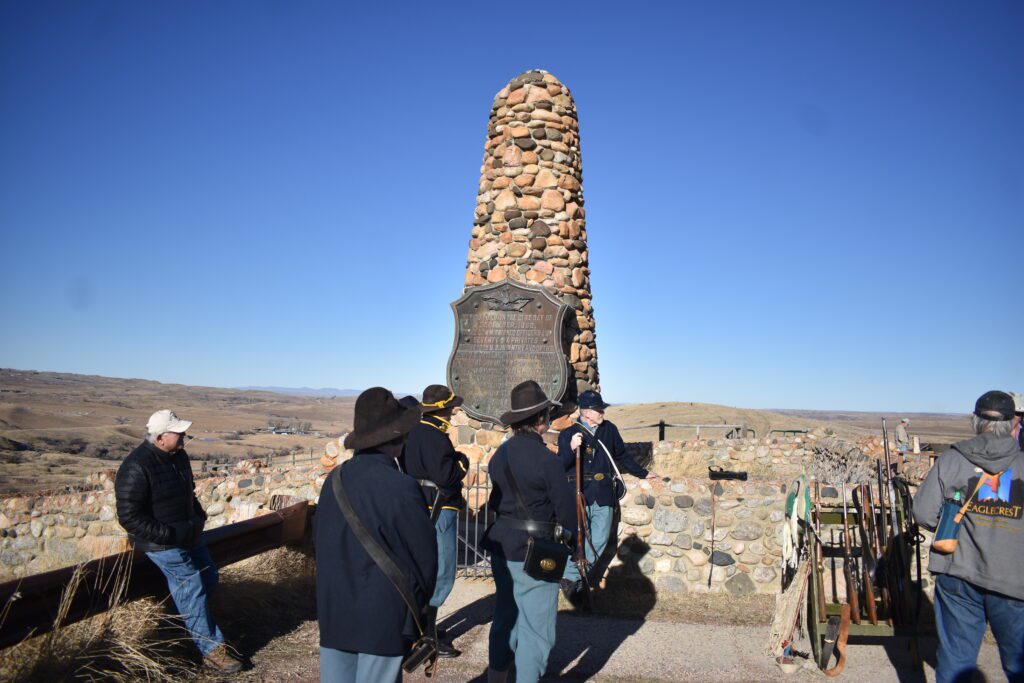News
History: The December 6 Fight at Fort Phil Kearny

On December 21, 1866, Captain William Fetterman and his command were wiped out by combined forces of Sioux and Cheyenne warriors not far from Fort Phil Kearny. However, there was a skirmish a few days earlier on December 6, which may have impacted the Fetterman Fight.
On that day, in response to an attack on a wood train outside the fort, Lt. Colonel Carrington led 50 mounted infantrymen, and Fetterman and Lt. Bingham lead 50 cavalry soldiers over Lodge Trail Ridge, hoping to trap the Indians between them. Due to the poor conditions of the cavalry mounts, the troops became very strung out, and the plan failed. Lt. Bingham and Sergeant Bowers, who were the primary cavalry officers as the fort, were killed.
This from a longer story about Fort Phil Kearny in the Sheridan Post, June 19, 1908 – One expedition is characteristic of many. On the afternoon of Dec. 6, the lookout on Sullivan Hills signaled that the wood train was attacked, and captain Fetterman, the senior captain present, was detailed with a squad of 40 mounted men, including fifteen cavalrymen, under Lts. Bingham and Grummond, with sergeant Bowers, a veteran of the Civil War, to relieve the wood train and drive the Indians toward Peno valley, while Carrington himself, with about a score of mounted infantry men, should sweep around the north side of Lodge Trial Ridge and intercept them.
Col. Carrington, in his official report says, “but six men turned the point with me one a young bugler of the Second cavalry, who told me that Lieutenant Bingham had gone down the road around the hill to my right. This seemed impossible, as he belonged to Fetterman’s command. I sounded the recall on this report, but in vain. The principal chief operating during the day attemped to secure his scalp. But dismounting, with one man to hold the horses, and reserving fire. I succeeded in saving the man and holding the position until Joined by Fetterman twenty minutes later. The cavalry that had abandoned him had not followed me, though the distance was short; but the Indians, circling round and yelling, nearly one hundred in number, with one saddle emptied by a single shot fired by myself did not venture to close in.
One man who was at the battle tells his story in The Sheridan Post, December 24, 1903. Of course, the headline could be a little misleading. (note: some of the misspellings were left as they are how the newspaper story was written at the time.)
Survivor of the Famous Fort Phil Kearny Massacre in December 1866. Mr, John T. Guthrie, who is an inmate of the United States soldiers’ home at Washington, D.C. and for several years a subscriber of The Weekly Laramie Republican, sends that paper a clipping from the Washington Times of Sunday, December 6 and the following note: “I have just paid my farewell visit to the adjutant’s office and headquarters of the Second United States cavalry now at Fort Meyer. Va.,as the troops of my old regiment will sail December 20 on the transport Kilpatrick for the Philippines, by way of the Suez canal. They will be joined by the troops of the regiment at Fort Ethan Allen, Vt. The transport is practically complete for the long voyage. It will leave New York on the 20th. During my visit to the headquarters at Fort Meyer there was a sorrowful parting with my comrades l am too old to go sailing to the Philippines, and it was like the saying. ‘Go away back old man and sit down.”
In this last visit I gave to Colonel Winfield Edgerly of the Second cavalry, a picture of the fight of what is now called Pony Creek. In this fight with the Indians, Lieutenant Bingham of Troop C, to which I belonged, was killed December 6, 1866, outside the walls of Fort Kearney, in the valley of the Pine Ridge, in the Big Horn mountains and the picture showed the fight and the death of our brave lieutenant at the hands of Sioux savages. The picture affords a full and satisfactory answer to inquiry about the lost history of that battle and lifts a curtain which has shrouded the history of the Second cavalry in that campaign ” Following are extracts from the article printed in the (Washington) Times of the 6th:
“Old John Guthrie of the Second Cavalry, a part of which is stationed at, Fort Myer, is the sole survivor of the Fort Phil Kearney massacre, which occurred in December of 1866.
“He is also the sole survivor of an ambush in which Lieutenant Bingham of Company C, Second cavalry, was killed and which occurred on December 6, 1866, and what was then called Cedar creek. Guthrie, an old man now. but his blue eyes-still retain much of the keenness and fire that enabled him to make a reputation for himself as an Indian scout In the Northwest many years ago. “Every year on December 6 he puts in extra work on the history he is writing of the stirring events in which he has taken part, because it is the anniversary on the day upon which his favorite officer was murdered by the Sioux. A few days, ago he completed a watercolor painting of the fight in which Bingham was killed, and an account of the affair as he saw it.
“At that time the Second cavalry was shut up in Fort Phil Kearney, for the Big Horn country was alive with Sioux, and it was unsafe for so small a body of soldiers to stir far from shelter. About midday, on December 6, a band of Indians ran down on a small herd or cattle that belonged to the fort, and with lances and sleigh bells, they stampeded the whole herd. Lieutenant Bingham and twelve troopers set out in pursuit of the Indians and the cattle, and ran them into a thick clump of willows on Cedar creek, now called Pony creek, about twelve miles from the fort.
As soon as the soldiers entered the thicket they found it alive with Indians. Realizing that they had been ambuscaded, they began at once to fight their way out. Lieutenant Bingham was shot down just as his horse was leaping a fallen sapling. Seeing they could not save him, the twelve troopers, every one of whom was wounded. got back to the fort as quickly as their horses could carry them.
Re-enforced by a large detachment from the fort, they returned to the scene of the fight, but found the Indians had fled, leaving the nude body of Lieutenant Bingham lying across the sapling where it had fallen. They had scalped him and shot his body full of arrows. A few weeks after this the massacre of Fort Phil Kearney occurred when the Sioux, under Black Cattle and Red Cloud, sent many another soldier to follow Lieutenant Bingham.
“There is no one in the Second cavalry now but John Guthrie, of Company C, who took part in this fight, so he alone is left to commemorate the anniversary of Lieutenant Bingham’s murder at Cedar creek, but he never fails to think of his lost officer on the 6th of every December and to mourn the loss of one for whom he retains memories of admiration and affection.”
The same story appeared in the Cheyenne Daily Leader, on December 20, 1903 and the headline read, Alone Survivor John T. Guthrie, Only Man In Fort Kearney Massacre Now Living, Inmate of National Soldiers’ Home at Washington.Tells Of Death of His Favorite Officer and Bloody Page In Wyoming. History—Each Year He Observes the Anniversary of the Tragedy. – John T. Guthrie, an inmate or the United States Home at Washington, D. C. is the only survivor of the Fort Phil Kearney massacre, which added another lurid chapter to Wyoming bloody early history. Recently the Washington Times had the following to say of the old warrior. (It then goes into the same story quoted above.)

Although there is no monument to the Dec. 6 Fight, there is one at the site of the Fetterman Battlefield.
Which in turn led to this story by one who objected to the facts presented. This from the Cheyenne Daily Leader, on December 24, 1903. – Was No Survivor of Fort Fetterman Massacre. All Reports to the Contrary. State Historian Coutant Gives True Facts Concerning the Celebrated and Bloody Page of the State. History—He Does Not Think John Guthrie Will Lay Claim to Presence at the Battle. The Leader isin receipt of the following communication from Colonel C. G. Coutant, author of “Coutants History of Wyoming.” Edltor Daily Leader: I noticed that you published on Sunday morning last an extract from the Washington Times, which claims that John Guthrie, of the Second United States cavalry, an inmate of the Soldiers’ home at Washington, is the sole survivor of the Fort Phil Kearney massacre. Every few years something is said in the newspapers about the”only survivor” of this massacre. This affair occurred on December 21, 1866. Lieutenant Colonel Fetterman went out of the fort to the rescue of the Wood train. The relief party consisted of fifty infantry men and two officers, and twenty-six cavalry men and one officer. Besides Lieutenant Colonel Fetterman, there were Captain Frederick. H. Brown and Lieutenant George W. Grummond. Two citizens Wheatley and Fisher, old frontiersmen, volunteered and joined the cavalcade as it moved out of the fort. Not one of the party returned alive. The twenty-six cavalry men mentioned “belonged to the Second United States Cavalry, and this, it appears, was the same regiment to which Mr. Guthrie belonged. I do not think that old John Guthrie will claim that he was with Fetterman on this occasion, and why outside newspaper writers will insist upon falsifying history I cannot understand. I content myself with giving the official facts, for I consider it important that they out there in our state know the truth. Respectfully yours. C. G. Coutant.
Perhaps Coutant did not read the entire story. Plus, the headline said the Fort Fetterman fight, which was a long way from Fort Phil Kearny.
Did the earlier battle, which killed two of the primary officers who were in charge of the cavalry, have an effect on the Fetterman defeat? Could the cavalry, under Bingham and Bowers, made a difference in the fight? As with most of history, it is a question that will never be answered.
There is a stone monument at the site of the Fetterman Battle. Each year, on the anniversary of the battle, December 21, Fort Phil Kearny holds a program to commemorate the battle. This year the program will held beginning at 10 at the Kearney Community Hall, followed at 11:30 by the tour of the Fetterman Battle Site near the monument.

